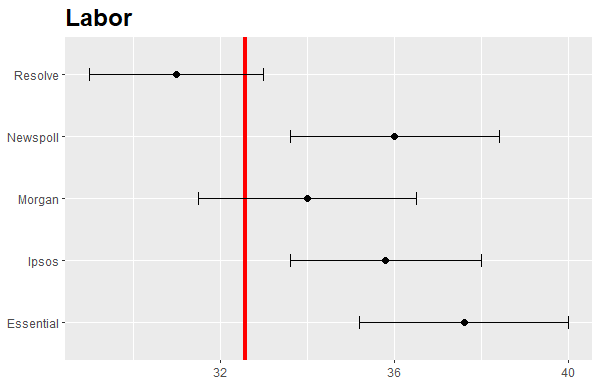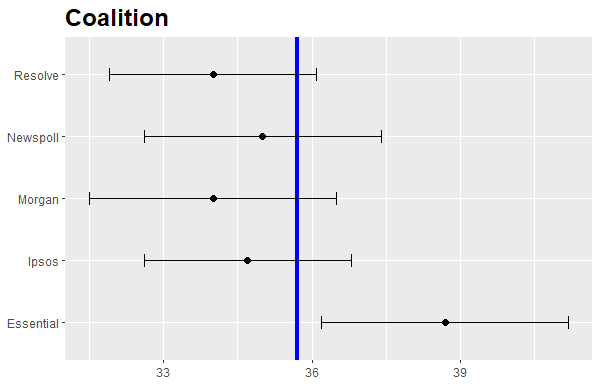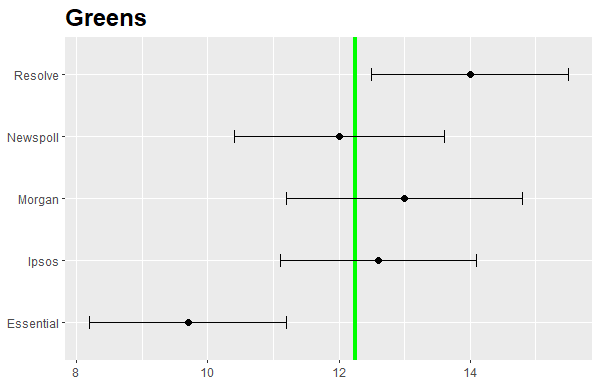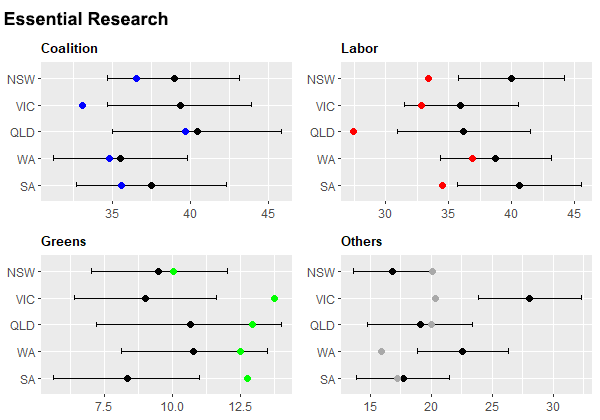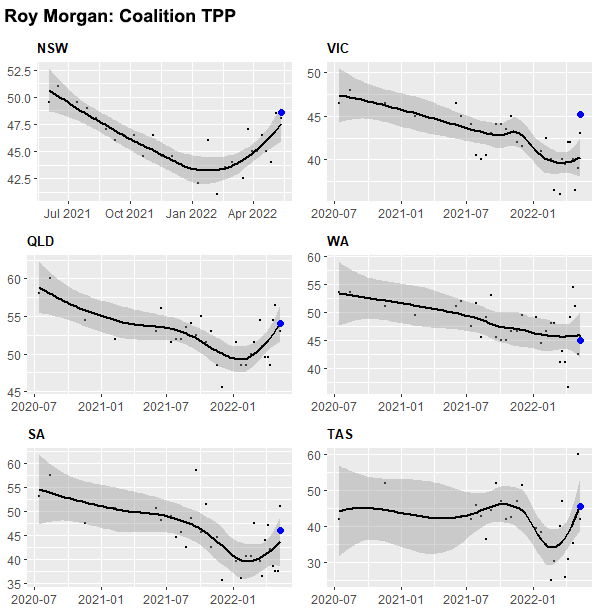Final resolutions of the ACT and NT Senate counts imminent, as the AEC also gets to work sorting out the final two-party preferred result.
Thursday, June 16
UPDATE: Tasmanian Senate result confirmed.
The next cab off the rank for the Senate is Tasmania at 3pm today, which should confirm a result of two each for Liberal and Labor and one each for the Greens and the Jacqui Lambie Network. Yesterday’s result in South Australia (see below) did not surprise, but my analysis of the ballot paper data has: the United Australia Party did a lot better on preferences than in 2019, sufficient to suggest that their candidate in Victoria, Ralph Babet, is well in the hunt for a final seat that I had hitherto thought most likely to go to the third Liberal, Greg Mirabella.
On this spreadsheet you will find my determination of how the various minor players’ preferences split between Labor, Liberal, Greens and UAP for the Senate in South Australia at both this election and in 2019. Most notably, the UAP only got 30.2% of One Nation preferences ahead of the other three in 2019, but this time they got 58.3%. The same pattern is evident in lesser degree among most other parties, particularly on the right. The one glaring exception is the Liberal Democrats, the results for which show how important ballot paper order is for this particular party. In 2019 they were well to the right of the ballot paper, polled 0.67%, and sent only 35.4% to the Liberals on four-party preferred. This time they drew the column A, got 2.20% and sent 61.2% to the Liberals, who were right nearby in column C.
To get a sense of what this might mean for Victoria, my Senate projection spreadsheet now contains a new sheet called “Vic 2”, which as much as possible replaces the preference data from Victoria in 2019 with the new results in South Australia. Note that I have left the distribution for the LDP undisturbed rather than swing it dramatically to the Liberals as per the South Australian result. If Antony Green is correct in his assessment that “lockdowns and changes in party registration rules” might mean more LDP preferences for the UAP at the expense of the Liberals, this assessment will actually be conservative with respect to their chances of overhauling Mirabella.
Whereas the existing projection gives the UAP only a 0.2% boost over the Coalition when One Nation preferences are distributed, the new one makes it 2.1% in “Scenario 1”, where Legalise Cannabis are excluded before One Nation, those two parties being closely matched at the previous exclusion. Competition from Legalise Cannabis for One Nation preferences in “Scenario 2” reduces this to 1.6%, but the difference comes back to them when Legalise Cannabis is excluded in later counts.
There are, in effect, three scenarios laid out here, depending on who drops out at close exclusions in the final stages. As noted, one involves Legalise Cannabis dropping out before One Nation, another vice-versa. On the first of these, I now have Mirabella dropping out before both UAP and Labor, and his preferences then deciding the result for the UAP. The second sets up another tight exclusion at the next round, with either Legalise Cannabis or the third Labor candidate going out next.
The former case, Scenario 2a, is essentially the same as Scenario 1, the only difference being the order of exclusion between Legalise Cannabis and One Nation. But in Scenario 2b, Labor’s exclusion unlocks what seems to me a surprisingly strong flow of preferences to the Liberals, precious few for the UAP, and not enough for Legalise Cannabis. On this scenario, Mirabella makes it over the line — just.
Wednesday, June 15
As noted below, the button will be pressed on the South Australian Senate result at 3pm today.
UPDATE: The result in South Australia, as expected, was 1. Simon Birmingham (Liberal), 2. Penny Wong (Labor), 3. Andrew McLachlan (Liberal), 4. Don Farrell (Labor), 5. Barbara Pocock (Greens), 6. Kerrynne Liddle (Liberal). The full preference distribution is here. Liddle ended short of a full quota at the final count with 140,008 votes (12.4%), ahead of Jennifer Game of One Nation on 107,672 (9.5%). At the previous count, third Labor candidate Trimann Gill was excluded with 89,740 (8.0%) to Game’s 97,755 (8.7%) and Liddle’s 107,705 (9.5%), though Liddle would have won at the final count either way.
The AEC now announces the button will be pressed at 3pm on Tasmania, which I consider a foregone conclusion of two each for Liberal and Labor and one each for the Greens and the Jacqui Lambie Network.
Tuesday, June 14
The Australian Electoral Commission has announced the buttons will be pushed on the Senate counts today for the Australian Capital Territory at 10am and the Northern Territory at 11am. There seems little doubt about the former result and none about the latter, but it will be interesting to see exactly how minor party and independent preferences flow through to what I am presuming will be a win for independent David Pocock over Liberal incumbent Zed Seselja in the ACT. It also seems likely that the resolution in South Australia and Tasmania is not far off.
For the lower house, the AEC is now conducting Coalition-versus-Labor counts in the 26 seats where the two-candidate preferred counts include independents or minor parties, a process that is a little over 10% complete. This will finally provide us with a definitive two-party preferred and swing results for the election as a whole. The count so far has been systematically favourably for the Coalition because they are starting with declaration votes, and in particular with postal votes, which account for over 80% of those counted so far. It is for this reason that they point to a collective swing to the Coalition of around 9%, which will assuredly not be the case after the ordinary votes are added.
My displays of the lower house results can be found here, but for the two-party preferred results you will need the AEC site.
UPDATE: Counts for the Northern Territory and the Australian Capital Territory resolved as anticipated. The preference distributions will be published later today. The button will be pressed on South Australia at 3pm local time tomorrow. Liberal candidate Andrew Constance has requested a recount after his defeat by 373 votes in Gilmore.
UPDATE 2: The distributions have been posted for both the Australian Capital Territory and Northern Territory. The ACT result was not close: at the final distribution, David Pocock had 103,618 votes (36.3%) and Zed Seselja had 81,485 (28.6%).
UPDATE 3: I had made the following calculations using the ballot paper data of how the various candidates’ preferences were apportioned between a) Labor, Liberal and David Pocock, b) Liberal and David Pocock, and c) Labor and Liberal. Since Labor polled almost exactly a quota, the question of preferences either to them or from them was academic so far as the count was concerned, but instructive with respect to voter behaviour.


